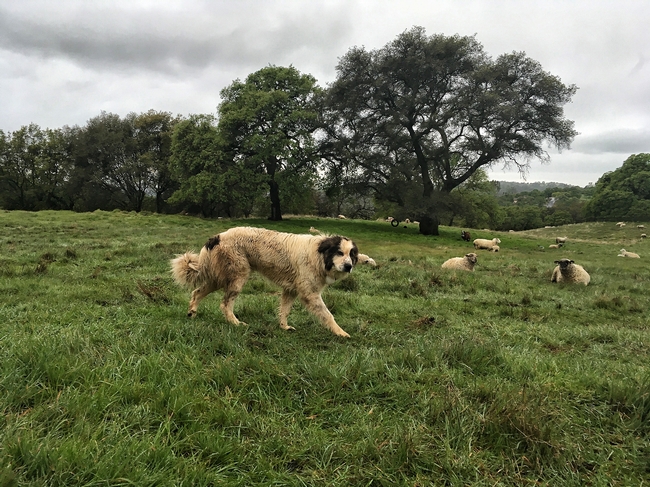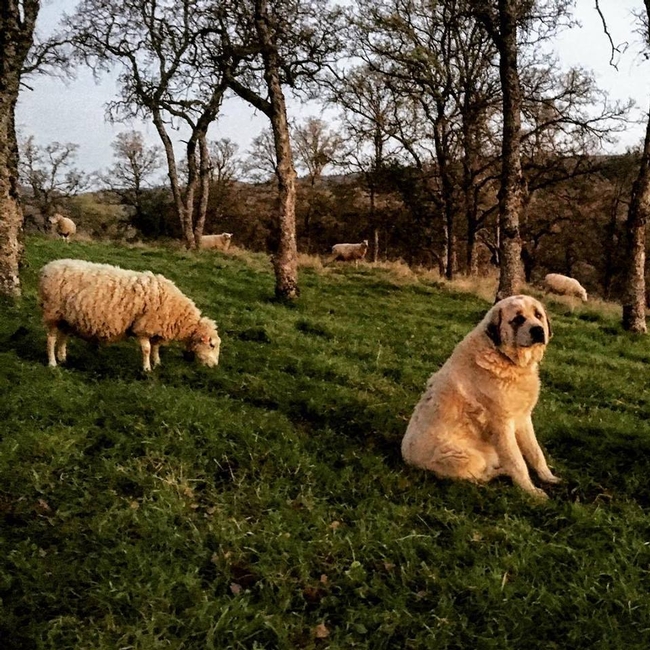
In "A Livestock Guardian Dog by Any Other Name: Similar Response to Wolves Across Livestock Guardian Dog Breeds," authors Dan Kinka of Utah State University and Julie Young of the Wildlife Services National Wildlife Research Center compare several new (to the United States) breeds of LGDs with the typical American "whitedog" (Great Pyrenees, Akbash, Anatolian, Maremma, and crosses of these breeds). Some producers believe that because the American whitedog breeds were initially selected to protect small ruminants from coyotes, they may not be well suited to deterring larger predators (especially gray wolves and grizzly bears). As part of the study, Kinka and Young imported kangals from Turkey, karakachans from Bulgaria, and cao de gado transmontanos from Portugal. These breeds were selected because they were typically used in their home countries to protect livestock from wolves and European brown bears - and they were considered to be human-friendly. The imported dogs were placed with sheep ranchers in Idaho, Montana, Oregon, Washington and Wyoming. The whitedogs used by these operations were considered to be a single control breed for the purposes of the study.
The study included direct observation of behavior during normal ranch operations, as well a decoy test designed to simulate mule deer and wolf encounters. Kinka and Young recorded five behavior components (activity, posture, vocalization, proximity to livestock, and out-of-view to the observer). Within these components a number of specific behaviors were documented (like scanning, investigation, vigilance, chasing, etc.).
While the authors noted some subtle differences in behavior and responses to simulated wildlife encounters between breeds, they noted "that kangals, karakachans, transmontanos and whitedogs spent equivalent proportions of time in most behaviors during both baseline sampling and simulated wolf encounters." They also found that LGD age and time of day influenced LGD behavior and that sex had no effect on any behavior - observations I've made with my own LGDs. For example, our LGDs always seem to be much more active and vigilant at dusk than during the middle of the day. Ultimately, the authors suggest, "the homogeneity of behavioral data for multiple LGD breeds suggests that regardless of breed, LGDs operate in much the same way. As such, breed may be a less important predictor of a 'good dog' than often suggested."
So what makes a good dog? Obviously, this definition varies from one operation to the next based on context. In our operation, a good dog needs to stay with our sheep, inside our electro-net fencing. A good dog shouldn't chew on or chase (or kill!) the livestock it is protecting. A good dog should be reasonably friendly with people but prefer the company of sheep. And good dog should deter coyotes, mountain lions, black bears and other minor predators in our environment.
If wolves continue to move south, I suspect my definition of a good dog might evolve. I know ranchers in the northern Rocky Mountains who are using larger dogs (including some of the breeds evaluated in this study). A large-scale targeted grazing contractor who has grazed sheep and goats in wolf territory in Montana and Idaho swears by intact male whitedogs. Last week, I visited a sheep permittee as they turned out onto a Tahoe National Forest grazing allotment approximately 12 miles northeast of where the California Department of Fish and Wildlife detected a GPS-collared wolf in early June. The ranch manager indicated he'd be adding more dogs to each of his two bands of sheep. For those of us in California, wolves are a wild card - our dogs have never had to contend with a large, pack-hunting predator.
While formal research on the behavioral attributes of successful LGDs is critical, we also need to share our on-the-ground experiences! What do you look for in an LGD in your operation? Do you use different dogs for different situations? I suspect each of us will have a slightly different answer to these questions! I hope you'll join in this conversation!
Reference
Kinka, D., Young, J.K., A Livestock Guardian Dog by Any Other Name: Similar Response to Wolves Across Livestock Guardian Dog Breeds, (2018), https://doi.org/10.1016/j.rama.2018.03.004
